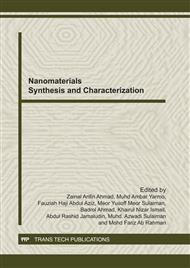p.393
p.398
p.402
p.408
p.412
p.417
p.422
p.427
p.434
Effect of Annealing Temperatures on Nanostructure of NBT Ceramics Prepared via Sol Gel Method
Abstract:
The effects of annealing temperatures on nanostructure of Na0.5Bi0.5TiO3 (NBT) ceramics prepared by sol gel method were investigated. Sol of NBT were synthesized using raw materials namely NaCH3COO, C6H9BiO6 and Ti (C4H9)4, while 2-methoxyethanol and glacial acetic acid were used as solvents. The sol of NBT was dried at 100°C for 24 hours, ground and subsequently annealed at three different temperatures namely 500°C, 600°C and 700°C for 2 hours. Microstructure and morphology of the ceramics were examined using XRD and SEM respectively. XRD revealed that the sample annealed at 500°C contains transient pyrocholore phase while materials annealed at higher temperatures has NBT as primary crystalline phase. The crystallite size dramatically increased from 10 nm to 80 nm with the rise of annealing temperatures. SEM micrographs confirmed the presence of irregular NBT nanoparticles with sizes of 50.0 nm and 80.0 nm for samples annealed at 600°C and 700°C respectively.
Info:
Periodical:
Pages:
412-416
Citation:
Online since:
October 2011
Price:
Сopyright:
© 2012 Trans Tech Publications Ltd. All Rights Reserved
Share:
Citation:


